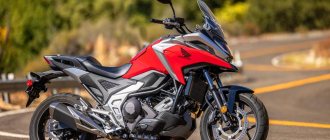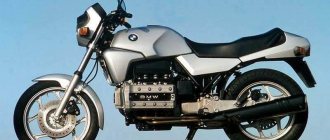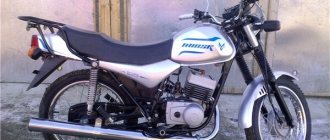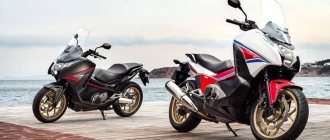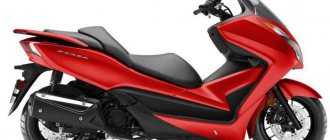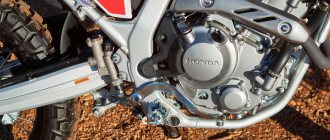Honda NT 650 V Deauville touring motorcycle model
was first introduced in 1998 based on the Honda NTV650 Revere model, a European modification of the Bros 650. The model was aimed exclusively at the European market and was not officially presented on other continents.
The motorcycle is also known by the name - Honda Deauville 650
.
For 2002, the Honda NT650V Deauville received several significant changes, the main ones being the combination brakes (visually distinguished by black 3-piston Nissin calipers at the front; previous versions had gold 2-piston Brembo calipers) and modified saddlebags (more secure latches and fastenings; increased capacity : left case - from 18 to 24 l, right - from 16.7 to 19.5 l). In addition, the engine received lightweight pistons and a catalyst to comply with new European emissions standards.
The Honda Deauville 650 engine is a 2-cylinder V-shaped liquid-cooled unit with a volume of 647 cc. see, producing 56 hp. power and 57 Nm of torque. Thanks to the use of a cylinder head with 3 valves per cylinder, the engine has good traction and fuel efficiency - fuel consumption on the highway, according to owners, easily fits into 5 liters. This engine was also installed on the Honda Bros 650 (NTV 650, Hawk) and Honda XL650V Transalp models.
The touring advantages of the model include advanced wind protection, built-in locking side cases, a cardan drive, a 19-liter fuel tank, audio preparation, adjustable footrests and a combined braking system.
2005 was the last year of production of the Honda NT650V Deauville model, after which it was replaced by the new Honda NT700V Deauville. Very often this model is considered as the third generation of Deauville 650, but the differences between one and the other models are very significant. In addition, the price of the Honda NT700V Deauville is approximately 50% higher than the cost of the Honda NT650V Deauville.
Specifications
Technical characteristics of Honda NT 650V Deauville:
| Model | Honda Deauville 650 |
| Motorcycle type | tourist |
| Year of issue | 1998-2005 |
| Frame | steel |
| engine's type | 2-cylinder, 4-stroke, V-shaped |
| Working volume | 647 cc cm. |
| Bore/Stroke | 79.0 x 66.0 mm |
| Compression ratio | 9,2:1 |
| Cooling | liquid |
| Number of valves per cylinder | SOHC, 3 valves per cylinder |
| Fuel supply system | carburetor, 2x Keihin CV 36 mm |
| Ignition type | digital transistor |
| Maximum power | 56 hp (41 kW) at 7900 rpm |
| Maximum torque | 57 Nm (5.8 kgm) at 6000 rpm |
| Transmission | 5-speed |
| type of drive | cardan |
| Front tire size | 120/70 ZR17 58W |
| Rear tire size | 150/70 ZR17 69W |
| Front brakes | 2 discs 296 mm, 2-piston calipers Brembo – NT650V-W,X,Y,1 2 discs 296 mm, 3-piston calipers Nissin – NT650V-2,3,4,5 |
| Rear brakes | 1 disc 276 mm, 1-piston caliper Brembo – NT650V-W,X,Y,1 1 disc 276 mm, 2-piston caliper Nissin – NT650V-2,3,4,5 |
| Front suspension | 41 mm telescopic fork (non-adjustable), travel – 130 mm – NT650V-W,X,Y,1 41 mm telescopic fork (non-adjustable), travel – 115 mm – NT650V-2,3,4,5 |
| Rear suspension | pendulum with monoshock absorber (6-stage adjustable preload), stroke - 120 mm |
| Length | 2215 mm |
| Width | 780 mm |
| Height | 1260 mm |
| Wheelbase | 1475 mm |
| Seat height | 814 mm |
| Acceleration to 100 km/h | 5.7 sec |
| Maximum speed | 179 km/h |
| Gas tank capacity | 19 l (including reserve - 3.2 l) |
| Motorcycle weight (dry) | 223 kg – NT650V-W,X,Y,1 228 kg – NT650V-2.3 233 kg – NT650V-4.5 |
| Motorcycle weight (curb) | 243 kg – NT650V-W,X,Y,1 248 kg – NT650V-2,3,4,5 |
Review of the Honda NT650V Deauville motorcycle
I have a 2002 Honda NT650V deauville. Moved from boxer. Basically I was looking for a little tourist. I really like the motik. The appearance is not flashy. Doesn't attract attention. It drives well, also steers and brakes. After 2001 there is a combined brake system. Again the cardan. Although for me it’s not mono-writing. Consumables are not expensive. There is rubber for it. 92 gasoline digests normally. I don’t even know what to write about him.
Hi all! My Deauville and my wife drove it for 4 seasons across half of Europe. good, cheap tourist. Fuel consumption is about 3.7-6 liters per 100, depending on the speed limit. The engine is reliable and high-torque, the dynamics are not particularly good, but the reliability is at the level. 5.5 sec -100 km/hour. In 30 thousand kilometers the speedometer drive cable has broken down. Thanks to its considerable weight, the motorcycle is very stable on the highway, the wind protection is at the level, after Doville I no longer want to ride other motorcycles without developed protection. 92 Benz sells well.
My firstborn. Our combined mileage is 4000 km. It handles well and is just great on the highway. Very responsive to counter-steering and at the same time stable in straight-line motion, potholes, etc. Doesn't tend to do wheelies or stoppies. Under very intense braking, the front wheel jumps on the asphalt, all behavior is quite predictable and controllable.
Maximum on the highway with touring glass is 170 km/h. 120-140 is his comfortable speed. Although the last time I went to Brest, it was 140-160 all the way and it didn’t bother me. Consumption 3.5 at 90, 5.3 at 120-130. A wonderful thing is the combined brakes. Tires Michelin Road Pilot, I haven’t driven the other one, this one has only advantages. By dynamics. This is not a sport. But 5.5 to hundreds - 99% of cars don’t accelerate like that :). The dynamics up to 120 are quite decent. At the same time, in the fields the second one pulls from 0. I drove with the second number and it’s not felt on the highway. His strong point is comfortable and economical movement to a given point. The footrests are cleverly made - for two positions of the feet, more sporty and tourist (such as city and highway), very convenient. Technically very reliable /nothing extra/.
The fit is comfortable, classic (for my height of 177 cm). The seat allows you to move back and forth. High clearance makes it possible to drive on sidewalks. Spacious trunks will come in handy when traveling and more. Safety bars covered with a plastic casing. Among the nice additions are foot protection shields from water, heated grips, an alarm system and a “cigarette lighter” in the side glove compartment.
At first I went and looked for cons. They were found in the form of a soft fork (treatment - oil change) and a small glass (touring ones are in tuning catalogs).
I enjoyed everything. 650 is quite enough for both the city and the highway. Not “sport” of course, but still. Due to the V-shaped engine, the width of the device is very small. I was stressing over the panniers. Wasted my nerves in vain. They are not wide, roomy and easy to use. The side ones open conveniently. There are straps inside to hold luggage. The combined brake system is worthy of respect; it has saved the day more than once. A 19 liter tank is enough for 250-300 kilometers. Wind protection at a high level. When it rains, your hands get a little wet. I'll put in regular plastic shields, they'll be enough.
I haven’t used the regular seats with music yet. But their presence indicates the seriousness of the engineers’ approach to the owner’s comfort. For the passenger there is a backrest on the central trunk and comfortable handles, the wife is always “for joy without traffic jams.”
During the season we managed to drive about 5 thousand miles. A little. But this is only for work and back and evening rides. It was not possible to get to the “long-distance” route. Summer trips to the countryside to the beach with my wife confirmed the correctness of my choice. They took a lot of things with them in their trunks, and even a melon for dessert was not superfluous.
Appearance
I won't write anything. There are tons of photos of Doville on the Internet. Therefore, I don’t see any point in telling you how beautiful he is.
Landing:
Here I “hit the top ten”: the distance from Chernigov to Solnechnogorsk in 12 hours and 2 stops. the numbers speak for themselves. Just in case, my height is 174 cm.
Control
No special skills are required when driving both on the highway and in the city. People often ask, “What’s it like on it after ebbing?” I'll say this. As soon as I bought it (September 2010), it was a little unusual, even with such a difference in weight, but when I sat on it in the spring, I had the feeling that I had been driving it all my life. It’s certainly not a problem in traffic jams, but I don’t feel any hellish discomfort.
Power point
In my subjective opinion, the thrust-to-weight ratio is in complete order. If you want 60, you want 160 (max 180) and I don’t need more. Besides, flying 200 on our wonderful roads is a direct path to success IMHO. Good traction from the bottom, no “kicks”, everything is exactly like a locomotive. Consumption depends on the speed of movement, I pour 92. work at home - about 5 liters. for Valdai with ebriks - 3.5l. MKAD - Kievka 160-180 - 7 or more.
Maintenance and repair
There is nothing special. Everything is simple and clear. True, there are a few hemorrhoids with plastic, but everything is learned by comparison, try changing which thread of the cable, say on a BMW CL 1200, then you will find out what hemorrhoids with plastic are. There are no problems with consumables. The most serious failure is the fuel pump. According to the behests of the fathers, I stuck 1100 rubles from the stove for 20 minutes of work.
Cardan
I will say this, for 15 thousand kilometers I spent 15 minutes of time and 200 rubles on servicing it. How long does it take to service a chain? The procedure for removing the rear wheel, say, from the SB400 is not much different. I got it right in choosing the main gear.
+ Comfortable seating, good engine, low fuel consumption, and of course, feel free to sign me up as a cardan fan!
— the side panniers are not removable (they make it difficult to remove the rear wheel, but not fatal). there is no fuel gauge, everything would be fine, but when the gas runs out, the pump pushes air and quickly breaks down, at different speeds it is difficult to focus on mileage.
2003 Honda DeVille, 650cc, 12k miles. from England
